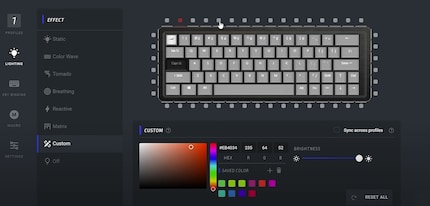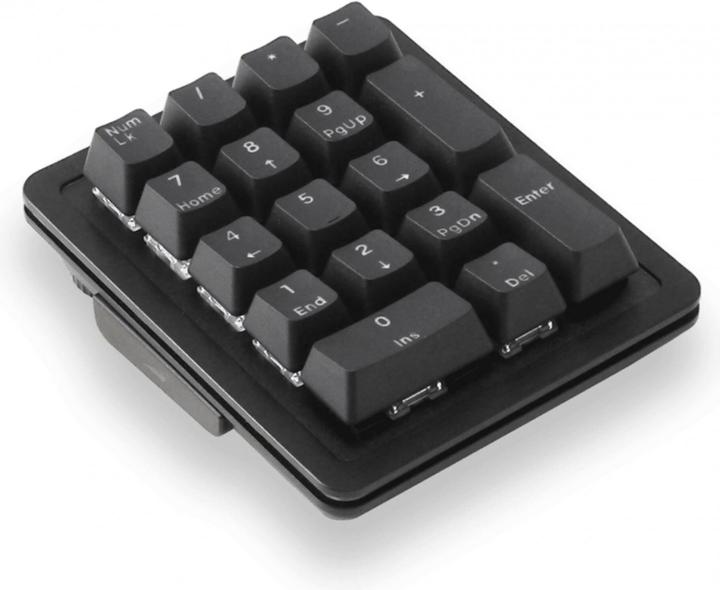

Mountain Everest 60: The small keyboard with attachable number pad convinces in the test
With the Everest 60, the manufacturer Mountain delivers a great prefabricated keyboard in a small form factor, which should also enchant many office gumshoes thanks to the attachable numeric keypad.
I love keyboards in the small form factor. Most people can't understand that because they lack the number pad. With Mountain's Everest 60, even number pad fans no longer have an excuse to try a small form factor keyboard. Because it comes with a dockable element for all Excel wizards. The result is a wonderfully modular keyboard that I can only criticize on a high level.

How to type on the Everest 60
The Everest 60 is a so-called tray-mount keyboard with sideways visible switches. The aluminum top plate and the circuit board, on which the switches are located, are directly connected to the lower part of the case.
This type of keyboard is rather hard to type on and does not yield when you press the keys fully. For me, it's too hard to type on for long periods of time, but that's a matter of taste.
You can hear how the keyboard sounds when typing in the video:
The Everest 60 sounds dampened, but still has its own character. There are several layers of dampening material inside: a layer of silicone at the bottom, foam for the circuit board right above it, and then the same material between the circuit board and the top plate. I like the sound well for a prefab keyboard.
The stabilizers, those things that keep your long keys balanced, don't rattle either. In return, the space and backspace keys make a ticking noise when pressed.
Mountain packs dedicated arrow keys into the 60 percent form factor - these are usually missing on such keyboards. To achieve this, the manufacturer shortens the auxiliary keys - Alt, Shift, Fn and co. - on the right side. They are all only one unit wide - the same size as the letter keys. Thus, everything looks compressed. Especially the short Shift key takes some getting used to. At the beginning, I often mistyped. I also have a hard time getting used to the special position of the Delete key in the lower right corner.

As you may have noticed from the pictures, my test sample of the Everest 60 comes in ANSI layout with US key bindings. Currently, the keyboard is not yet available in ISO layout.
Features and scope of delivery
The Everest 60, including the optional numeric keypad, is a separate system. It is therefore not compatible with the Everest Core and its accessories. This is due to the somewhat narrower edges of the 60.
Otherwise, some things are the same on the Everest 60 as on the Core. It also has three USB-C ports in the back. Thus, you can decide whether to connect the included coiled USB cable or your own on the left, center or right. Unfortunately, the ports do not support passthrough. So you can't connect other devices to your computer via the keyboard.

The magnetic feet to change the typing angle are also back. This is a nice feature and looks more premium than the plastic folding feet on most keyboards.
Speaking of plastic, aside from the brushed aluminum top cover, the Everest 60 is made of plastic. This also applies to the side covers of the USB-C ports where you dock the numeric keypad.

Separating the plastic from the aluminum top plate is an RGB LED strip that runs all the way around the keyboard. While I'm not a fan of RGB, it looks really awesome when I dock the number pad and the light show continues seamlessly around the number pad. The visible switches make the lighting look even more intense.
Overall, the keyboard's build quality is very good.
Keycaps, switches and stabilizers
Unlike the Core, Mountain relies on its own switches for the 60. My test sample comes with the Mountain Linear 45, a factory-lubricated linear switch with 45 grams of release force. The key travel to release is two millimeters, and the total travel is four millimeters. The switch has three pins, so it is a plate mount switch. However, the Everest 60's circuit board also supports PCB mount switches with five pins. The upper part of the switch is made of transparent polycarbonate, which allows the LED lighting to shine through better. The switches are quick and easy to replace thanks to the hot-swap PCB.

Overall, the switches are not bad. The attached grease does its job and they feel relatively soft when pressed. Unfortunately, the spring produces a very audible ping noise that bothers me. If you are used to switches in prefabricated keyboards and like light linear keys, you will definitely enjoy the switches.
Mountain has improved the keycaps. They were my biggest point of criticism with the Everest Core. The keycaps of the 60 do not completely convince me either. They are okay. Instead of ABS plastic, they are now made of PBT plastic. This tends to attract fingerprints less quickly. The keycaps are manufactured in a double molding process. The lettering is transparent so that RGB light can shine through.

However, the inscriptions are inconsistent and not always in the same place on the keycap. Furthermore, they are not always the same size. On the short, right shift key the letters are small, but on the Fn key diagonally next to it they are huge. That triggers me.
Mountain uses so-called plate-mount stabilizers. They are attached to the top plate and not the PCB. Usually, these stabilizers tend to rattle when typing. This is not the case with the 60. This is because they are lubricated. A damping pad, which the manufacturer attaches to the circuit board, additionally reduces the rattling when typing. Mountain shows a lot of attention to detail here. Unfortunately, the stabilizers of my test sample produce a ticking noise after a few days of typing. The right shift key also feels mushy; it seems to stick slightly when pressed down. This is a sign of too much grease.

The numpad
A numpad is optionally available for the keyboard, which can be attached on the left or right. The Everest should therefore also appeal to fans of full-size keyboards. If you attach the numpad, you only lack dedicated F and navigation keys in comparison. However, you can reach both quickly and comfortably via the Fn key.

The attachment mechanism works like on the Everest Core. You can use a slider on the bottom to pull out the USB-C port for mounting on the right or left. With a corresponding cable, you can also mount the numeric keypad further away from the 60 on your desk.

Even when plugged in, the keyboard saves a lot of space on the desk. As it is, it's only about 55 millimeters longer than my Ikki68 Aurora, a 65 percent keyboard. When I move the board, the numeric keypad sticks to the 60, and when I lift the keyboard in the middle, it sticks to it too. Only when I lift the connected elements from the side with both hands does the number pad come off.

The Base Camp or the software
As with the Everest Core, you need the proprietary Base Camp software to personalize the 60. Here you can adjust the lighting and also remap keys and create macros.

Overall, the software is solid. It always worked in my test. However, I am not a fan of the design and layout. It all seems a bit cluttered.
Cool part
Overall, the Everest 60 is a good keyboard in a small form factor. Especially with the number pad, it is a recommended buy. If you're gaming and working with the keyboard, it's perfect. When gaming, you have the keyboard close to the mouse and when working, you dock the number pad.
Concrete points of criticism on the board are the stabilizers and the keycaps. Otherwise, there is nothing to criticize. The docking of the numpad is simply ingenious. RGB fans are taken care of. With hot-swap, solid switches and good build quality, the Everest 60 is fun to use.
I recommend the 60 especially in combination with the numeric keypad. Only the Everest 60 has too much competition from other manufacturers. I would prefer the recently tested GMMK2 in the 65 percent form factor - especially because of the special arrangement of the left shift and delete keys on the 60. The Everest is also currently priced above the GMMK 2 - with or without the numpad.
Wenn du meine Artikel regelmässig liest, weisst du, dass ich derzeit auf einer Split-Ortho-Tastatur schreibe. Dieses Review ist im Vorfeld des Selbstversuchs entstanden.From big data to big brother, Cyborgs to Sci-Fi. All aspects of technology and society fascinate me.



